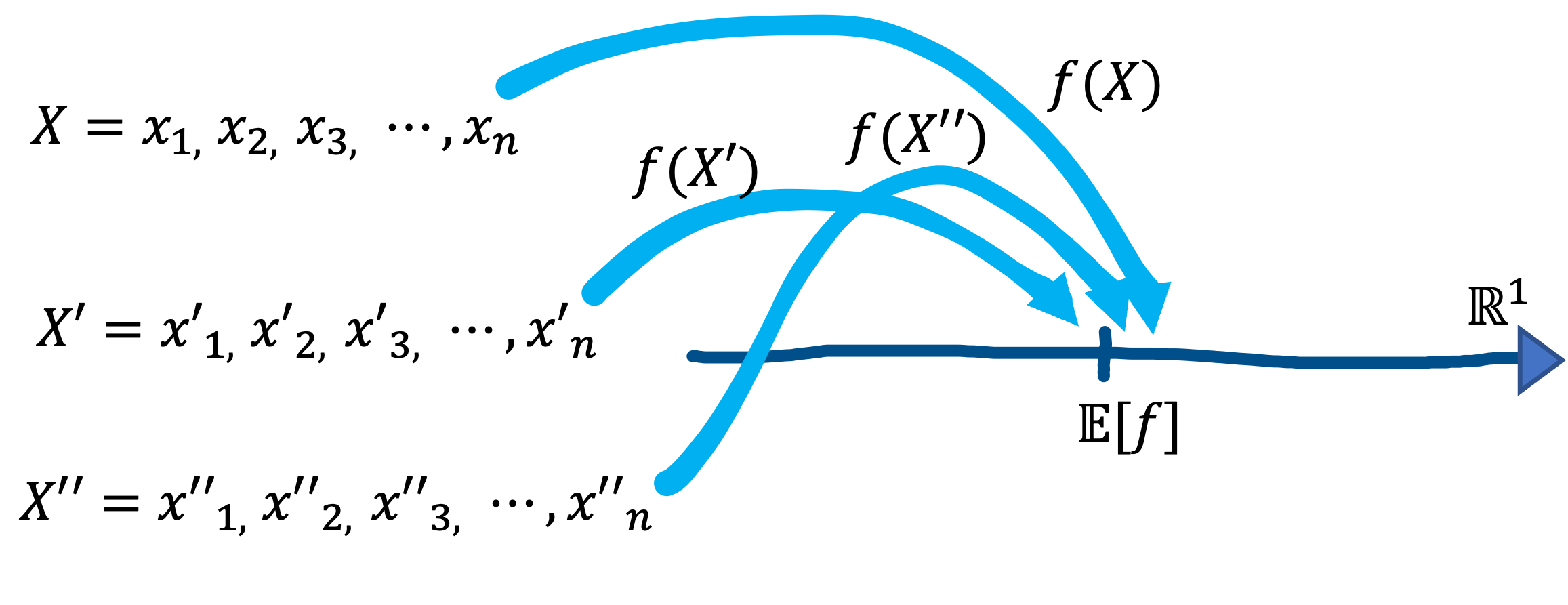What is concentration? At the beginning of Boucheron’s book and lecture series by Sudeep Kamath, it is explained by the following quotes from Talagrand: A random variable that smoothly depends on the influence of many independent random variables satisfies Chernoff type bounds and is essentially constant. Letting $f: \mathbb{R}^{n} \rightarrow \mathbb{R}^{1}$ as $Z = f(x_{1}, x_{2}, \cdots, x_{n})$ for independent variables $x_{1}, x_{2}, \cdots, x_{n}$, what the concentration means is that \[ \mathbb{P}\{ |Z - \mathop{\mathbb{E}} \left \lbrack Z \right \rbrack | \leq t\} \label{eq:1}\tag{1} \] is small.

Sub-Gaussianity and Outline
As we will see, $ \mathbb{P}\{ |Z - \mathop{\mathbb{E}} \left \lbrack Z \right \rbrack | \leq t\} $ is bounded by the logarithm of the moment generating function, \[ \psi_{Z - \mathop{\mathbb{E}}\left \lbrack Z \right \rbrack }(\lambda) = \log \mathop{\mathbb{E}} \exp \left (\lambda (Z - \mathop{\mathbb{E}} \left \lbrack Z \right \rbrack) \right ) \label{eq:2}\tag{2} \] $\forall \lambda \geq 0$, and thus our interest is to suppress $\psi_{Z - \mathop{\mathbb{E}}\left \lbrack Z \right \rbrack }(\lambda)$ so that Eq.$\,$($\ref{eq:1}$) is sufficiently small, i.e., $Z$ is concentrated arround $\mathop{\mathbb{E}} \left \lbrack Z \right \rbrack$. We know that Gaussian density is concentrated on the mean and rapidly decreases as it spreads toward the tail. This is a property of the Gaussian, but by controlling $\psi_{Z - \mathop{\mathbb{E}}\left \lbrack Z \right \rbrack }(\lambda)$, we can have a Gaussian-like concentration even for variables $Z=f(X)$ that do not follow the Gaussian. In particular, if \[ \psi_{Z - \mathop{\mathbb{E}}\left \lbrack Z \right \rbrack } \leq \frac{\lambda^{2}}{2} v, \label{eq:3}\tag{3} \] $Z$ behaves like the Gaussian with the variance $v$. The entropy method and transportation method are methods that control $\psi$ through the different but equivalent forms to Eq.$\,$($\ref{eq:3}$).
Cramer-Chernoff method
In this post, we see why $ \mathbb{P}\{ |Z - \mathop{\mathbb{E}} \left \lbrack Z \right \rbrack | \leq t\} $ is bounded by $\psi_{Z - \mathop{\mathbb{E}}\left \lbrack Z \right \rbrack }(\lambda)$ and where the condition $\psi_{Z - \mathop{\mathbb{E}}\left \lbrack Z \right \rbrack } \leq \frac{\lambda^{2}}{2} v $ comes from. To this goal, letting $Y = Z - \mathop{\mathbb{E}}\left \lbrack Z \right \rbrack $, we begin by \[ \mathbb{P}\{ Y \geq t\} = \mathbb{P}\{ \exp(Y) \geq \exp(t)\} = \mathbb{P}\{ \exp(\lambda Y) \geq \exp(\lambda t)\} \leq \frac {\mathop{\mathbb{E}}\left \lbrack \exp(\lambda Y) \right \rbrack} {\exp(\lambda t)}, \] where the last term is from Markov’s inequality. The logarithm of the moment generating function comes from the above. Using the definition of Eq.$\,$($\ref{eq:2}$) and introducing \[ \psi_{Y}^{*}(t) = \sup_{\lambda \geq 0} (\lambda t - \psi_{Y}(\lambda)), \] we obtain Chernoff inequality \[ \mathbb{P}\{ Y \geq t\} \leq \exp(- \psi_{Y}^{*}(t)). \label{eq:4}\tag{4} \]
Chernoff inequality for Gaussian random variable
We want to find $\lambda$ that minimizes the upper bound of Eq.$\,$($\ref{eq:4}$), $\exp(- \psi_{Y}^{*}(\lambda))$, and we consider its concrete form for the Gaussian random variable. Let $Y$ be a centered Gaussian random variable with variance $v$ and thus a sample from $\mathcal{N}(0, v)$. Note that it has not lost its generality compared to thinking $Z$ sampled from $\mathcal{N}(\mu, v)$ becuase of the relationship $Y = Z - \mathop{\mathbb{E}} \left \lbrack Z \right \rbrack$. From the fact that the logarithm of the moment generating function for the Gaussian random variable is \[ \psi_{Y} = \frac{\lambda^{2}}{2} v, \] $\psi_{Y}^{*}(t)$ can be written as \[ \psi_{Y}^{*}(t) = \lambda t - \frac{\lambda^{2}}{2} v. \] We want to know $\lambda$ that maxmizes $\psi_{Y}^{*}(t)$, and it is obtained as \[ \frac{\partial }{\partial \lambda} \psi_{Y}^{*}(t) = t - \lambda v = 0 \Leftrightarrow \lambda = \frac{t}{v}. \] Thus we have $ \psi_{Y}^{*}(t) = \frac{t^{2}}{2 v}, $ and Chernoff inequality for the Gaussian random variable is \[ \mathbb{P}\{ Y \geq t\} \leq \exp( - t^{2} / {2 v}). \] \[ \]